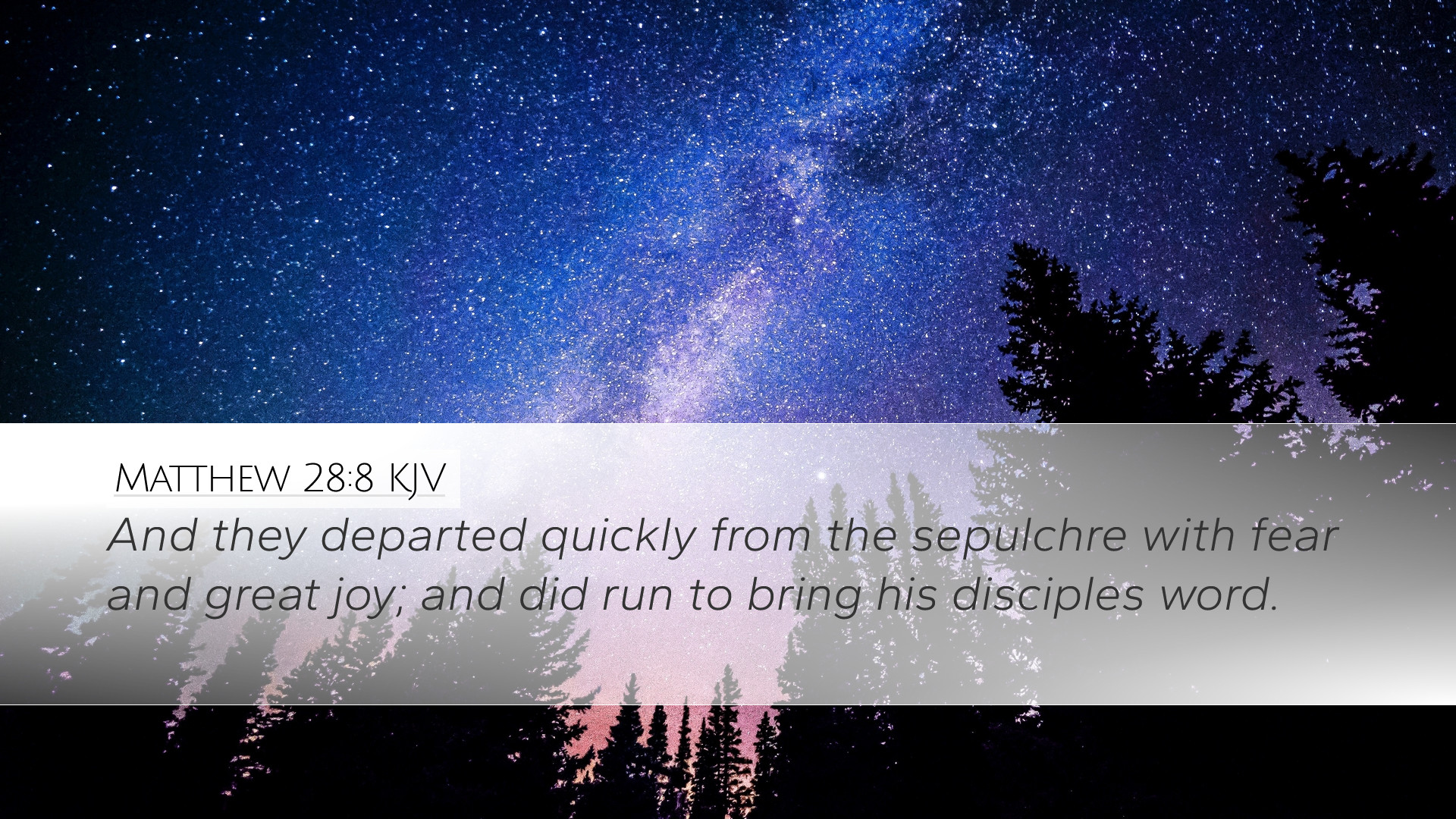Commentary on Matthew 28:8
Verse: Matthew 28:8
“And they departed quickly from the sepulchre with fear and great joy; and did run to bring his disciples word.”
Introduction
This verse captures a pivotal moment in the New Testament — the aftermath of the resurrection of Jesus Christ. The emotions and actions of the women who visited the tomb provide profound insights into the nature of faith, the promise of resurrection, and the mission of believers. Commentaries from Matthew Henry, Albert Barnes, and Adam Clarke shed light on the theological depth of this passage.
Contextual Overview
The passage comes at the conclusion of the Gospel of Matthew, shortly after the angel of the Lord announces the resurrection to Mary Magdalene and the other Mary. This event fulfills Jesus’ prophecies regarding His death and resurrection, marking the triumph over death and sin.
Analysis of Key Themes
Emotions: Fear and Joy
The verse presents a striking juxtaposition of emotions — fear and joy. As Matthew Henry notes, this fear does not stem from terror alone; it is a reverent awe in the presence of the divine miracle of resurrection. The women, having encountered the angel and experienced the reality of an empty tomb, reflect a foundational aspect of Christian faith — that God’s actions often invoke both fear and joy.
Albert Barnes reiterates that their quick departure denotes urgency, suggesting that the fear they felt did not paralyze them but motivated them to hurry back to the disciples. The joy they experienced flows from the realization that death has been defeated, infusing their hearts with hope and mission.
Mission to Spread the News
The women’s immediate response—to run and tell the disciples—highlights a significant principle of evangelism in Christian theology. Adam Clarke emphasizes the call to action present in this verse. The response to the resurrection is not complacency; rather, it is an imperative to share the good news. This aspect resonates deeply with the Great Commission that follows in Matthew 28:19–20.
The Role of Women in the Resurrection Narrative
The active participation of women at the tomb serves as a critical commentary on gender roles within the early church and Scriptural narrative. As noted by Matthew Henry, these women are the first messengers of the resurrection, signifying that God values all vessels for His message. This challenges historical marginalization within ecclesiastical structures and affirms the empowerment of women in ministry contexts.
Theological Implications
The resurrection is not merely a miraculous event; it serves as the cornerstone of Christian hope. Albert Barnes applies this verse to illustrate the believer’s response to Christ's resurrection. The transformation from fear to joy models the journey of faith — from the dread of sin and separation from God to the joy found in reconciliation and eternal life.
Exegetical Insights
Departure from the Sepulcher
Verse 8 describes the women’s departure from the sepulcher. Adam Clarke draws attention to the significance of the sepulcher itself, a place of death transformed into a site of life. Their removal from this space symbolizes leaving behind fear and despair, moving towards a new understanding of life through resurrection.
The Angelic Announcement
Prior to this verse, the angel's message resounds in the reader’s mind. Matthew Henry comments on how the angel's declaration — “He is not here: for he is risen” — serves as the gospel's heart. This announcement shifts the women’s perspective and initiates the joyous task of proclamation.
Practical Applications
For pastors and church leaders, this passage serves as a reminder of the vitality of spreading the gospel. The urgency and joy exhibited by the women illustrate that the response to the resurrection should inspire a proactive faith — a charge to evangelize with fervor and passion.
- Encouragement in Times of Doubt: Just as the women went forth with fear and joy, believers today can embrace the duality of emotions in their faith journey, trusting that God is at work even amidst uncertainty.
- Empowerment for All: The support and encouragement of women in ministry roles should be embraced within church communities, reflecting the inclusive nature of Jesus’ message.
- Urgent Proclamation: The call to respond to the resurrection with urgency remains; churches are called to equip and mobilize believers to share the hope of the gospel in their communities.
Conclusion
Matthew 28:8 encapsulates the essence of Christian faith—a faith that brings together fear and joy, motivates action, and leads to the proclamation of the resurrection of Christ. Drawing from the insights of revered commentators such as Matthew Henry, Albert Barnes, and Adam Clarke, one recognizes the invitation embedded in this moment to step boldly into the world with the good news, transformed by the reality of the resurrection.


